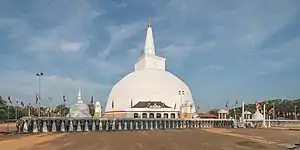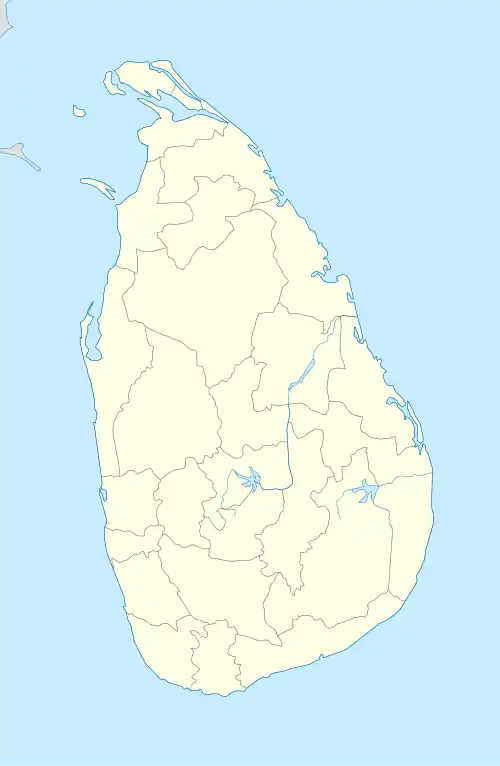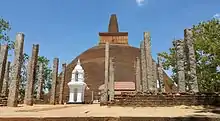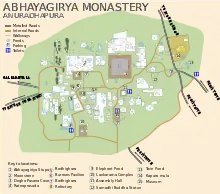Anuradhapura
Anuradhapura (Sinhala: අනුරාධපුරය, romanized: Anurādhapuraya; Tamil: அனுராதபுரம், romanized: Aṉurātapuram) is a major city in Sri Lanka. It is the capital city of North Central Province, Sri Lanka and the capital of Anuradhapura District. Anuradhapura is one of the ancient capitals of Sri Lanka, famous for its well-preserved ruins of an ancient Sinhala civilization. It was the third capital of the kingdom of Rajarata, following the kingdoms of Tambapanni and Upatissa Nuwara.
Anuradhapura
අනුරාධපුර அனுராதபுரம் | |
|---|---|
 | |
 Anuradhapura Location in Sri Lanka | |
| Coordinates: 8°21′0″N 80°23′7″E | |
| Country | Sri Lanka |
| Province | North Central Province |
| District | Anuradhapura |
| Established | 4th century BC |
| Government | |
| • Type | Municipal Council |
| Area | |
| • City | 7,179 km2 (2,772 sq mi) |
| • Urban | 36 km2 (14 sq mi) |
| Elevation | 81 m (266 ft) |
| Population (2012) | |
| • City | 50,595 |
| • Density | 2,314/km2 (5,990/sq mi) |
| Demonym(s) | Anuradhians |
| Time zone | UTC+5:30 (Sri Lanka Standard Time Zone) |
| Postal code | 50000 |
| Official name | Sacred City of Anuradhapura |
| Criteria | Cultural: ii, iii, vi |
| Reference | 200 |
| Inscription | 1982 (6th session) |
The city, now a World Heritage site, was the centre of Theravada Buddhism for many centuries. The city lies 205 km (127 mi) north of the current capital of Colombo in the North Central Province, on the banks of the historic Malvathu River. It is one of the oldest continuously inhabited cities in the world and one of the eight World Heritage Sites of Sri Lanka.
Urban Area
- Iron Age
Although according to historical records the city was founded in the 5th century BC, the archaeological data put the date as far back as the 10th century BC.[1]
Buddhism and Anuradhapura
Anuradhapura was a major intellectual centre for early Theravāda Buddhism, home to revered Buddhist philosophers including Buddhaghosa.[2]
During the late Anuradhapura period, the royal family and nobility of Sri Lanka strongly supported Buddhism. As such, they frequently commissioned works of art and donated these items to Buddhist temples. In return, the temple and local Buddhist community supported the king's rule. Art works featuring depictions of Avalokitesvara, the Bodhisattva of Mercy and Compassion, became increasing popular.[3]
Modern era
European discovery
The area was uninhabited for many centuries, but the local population remained aware of the ruins. In Robert Knox's 1681 An Historical Relation of the Island Ceylon, he wrote: "At this City of Anurodgburro is a Watch kept, beyond which are no more people that yield obedience to the King of Candy".[4] In 1821, John Davy wrote that: "Anooradapoora, so long the capital of Ceylon, is now a small mean village, in the midst of a desert. A large tank, numerous stone pillars, two or three immense tumuli, (probably old dagobahs,) are its principal remains. It is still considered a sacred spot; and is a place of pilgrimage."[5]
Excavations

Various excavations have taken place at the site, beginning in 1884-86 by Stephen Montagu Burrows.[6]
According to carbon dating, the ruins excavated were from the 10th-century BC.
Places of veneration
Other structures

Demographics
| Ethnicity | Population | % Of Total |
|---|---|---|
| Sinhalese | 51,775 | 91.42 |
| Sri Lankan Moors | 3,825 | 6.75 |
| Sri Lankan Tamils | 850 | 1.50 |
| Indian Tamils | 45 | 0.08 |
| Other (including Burgher, Malay) | 137 | 0.24 |
| Total | 56,632 | 100 |
Source: www.statistics.gov.lk - Census 2001
Transportation
Anuradhapura is served by railway and highways. The Northern railway line connects Anuradhapura with Colombo, Jaffna, and Kankesanthurai. Anuradhapura railway station is the city's rail gateway, with major services, such as the Yal Devi, Uttara Devi stopping there.
There are number of bus routes passing through Anuradhapura from Colombo to northern province . Some of them are 04, 15, 57, 87 etc.
Anuradhapura is a central city in Sri Lanka. It is directly connected by road to a large number of major cities and towns on the island. By road, it is connected to Vavuniya, Dambulla, Matale, Puttalam, Trincomalee, Jaffna, Kurunegala and Kandy.
References
- Deraniyagala, SU. The Prehistory of Sri Lanka, Vol II, Department of Archaeological Survey, Colombo: 1992. p435.
- Buddhaghosa. (1999). The path of purification : Visuddhimagga. Ñāṇamoli, Bhikkhu, -1960. (1st BPE Pariyatti ed.). Seattle, WA: BPE Pariyatti Editions. ISBN 1928706002. OCLC 44927676.
- Birmingham Museum of Art (2010). Birmingham Museum of Art : guide to the collection. [Birmingham, Ala]: Birmingham Museum of Art. p. 57. ISBN 978-1-904832-77-5.
- Robert Knox (1681), Historical Relation chapter 2, full quote "There are besides these already mentioned, several other ruinous places that do still retain the name of Cities, where Kings have Reigned, tho now little Foot steps remaining of them. At the North end of this Kings Dominions is one of these Ruinous Cities, called Anurodgburro, where they say Ninety Kings have Reigned, the Spirits of whom they hold now to be Saints in Glory, having merited it by making Pagoda’s and Stone Pillars and Images to the honour of their Gods, whereof there are many yet remaining: which the Chingulayes count very meritorious to worship, and the next way to Heaven. Near by is a River, by which we came when we made our escape: all along which is abundance of hewed stones, some long for Pillars, some broad for paving. Over this River there have been three Stone Bridges built upon Stone Pillars, but now are fallen down; and the Countrey all desolate without Inhabitants. At this City of Anurodgburro is a Watch kept, beyond which are no more people that yield obedience to the King of Candy. This place is above Ninety miles to the Northward of the City of Candy. In these Northern Parts there are no Hills, nor but two or three Springs of running water, so that their Corn ripeneth with the help of Rain."
- John Davy (1821), An Account, full quote: "Anooradapoora, so long the capital of Ceylon, is now a small mean village, in the midst of a desert. A large tank, numerous stone pillars, two or three immense tumuli, (probably old dagobahs,) are its principal remains. It is still considered a sacred spot; and is a place of pilgrimage. This information was collected partly from the natives, and partly from an officer who visited it during the rebellion."
- Department of Archaeology - Sri Lanka: "The first methodical excavation of the Department of Archaeology had been carried out by Mr. S.M. Burrows in Anuradhapura and Polonnaruwa during 1884 to 1886. Subsequently, the exploration and excavation activities were undertaken mainly in Anuradhapura and Sigiriya with the guidance of Mr. H.C.P. Bell in 1890. Similarly, archaeological excavations in Anuradhapura and other areas of the island were carried out under the supervision of Mr. E.M. Ayrton (1912-1914) and Mr Raja De Silva (1983). Mr. E.M. Hocart who was appointed as the Commissioner of Archaeology in Sri Lanka in 1926, carried out excavations using the method of stratification, in places such as Mathota, Pomparippu, Anuradhapura inner city and Ambalantota."
- Harischandra, B. W.: The Sacred City of Anuradhapura, Reprint. New Delhi, Asian Educational Services, 1998.
- Nissanka, H.S.S.: Maha Bodhi Tree in Anuradhapura, Sri Lanka : The Oldest Historical Tree in the World, New Delhi 1996, (Reprint. Vikas)
- R. A. E. Coningham.: The Origins of the Brahmi Script Reconsidered: The New Evidence from Anuradhapura, Minerva 8(2): 27–31, 1995.
- R. A. E. Coningham.: Anuradhapura Citadel Archaeological Project: Preliminary Results of a Season of Geophysical Survey. South Asian Studies 10: 179–188, 1994.
- A. Seneviratne.: Ancient Anuradhapura The Monastic City, Archaeological Department of Sri Lanka. p. 310, 1994.
- S. M. Burrows, The Buried Cities of Ceylon - A Guide Book to Anuradhapura and Polonaruwa Reprint, p. 120, 1999.
External links
| Wikimedia Commons has media related to Anuradhapura. |
| Wikivoyage has a travel guide for Anuradhapura. |
| Wikisource has the text of the 1911 Encyclopædia Britannica article Anuradhapura. |
- UNESCO World Heritage List - Sacred City of Anuradhapura
- Anuradhapura Case-Study by students of School of Planning & Architecture
- Sacred City of Anuradhapura
- The Complete Travel Guide of Anuradhapura